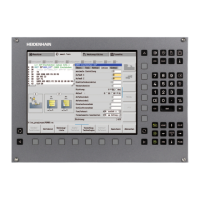1040 HEIDENHAIN Technical Manual MANUALplus 620
6.18.13 C-axis operation
In C-axis operation, an axis and a spindle are driven by the same motor.
The MANUALplus 620 supports the following configurations for C-axis
operation:
The C axis and spindle use the same servo drive. Because the speed
encoder is built into the motor, it measures both the C axis and the spindle.
The C axis and spindle each use their own servo drive. Because the speed
encoder is built into the motor, there are separate speed encoders for the
C-axis and the spindle.
The C axis and spindle use one position encoder.
The C axis and spindle each use their own position encoder.
The axis and spindle can be operated as an analog or digital axis or spindle.
Separate parameter sets for the spindle and C axis are required in all
configurations. In these parameter sets, you define the servo drive, the
position encoder and speed encoder as well as the other details separately for
the spindle and C axis.
Define separate parameter sets for spindle and C-axis operation.
The commissioning must be performed for spindle operation as well as for
C-axis operation.
If you use only one position encoder for both the spindle and the axis, the axis
display keeps running while the spindle is in operation:
Before switching from the axis to the spindle, save the actual position value
of the axis with Module 9146. This ensures that the axis display remains at
the last value, even when the spindle is rotating.
Before switching from the spindle to the axis, recover the actual position
value of the axis with Module 9146.
If you save the actual position value with Module 9146 and then close the
position control loop, or if the position control loop is closed and the actual
position value is then saved with Module 9146, the error message Actual
position value saved <Axis> appears. The error message triggers an
emergency stop.
The C-axis position controller should be commissioned in the gear range
that is actually used for positioning. If possible, use the lowest gear range
to ensure optimum controllability.

